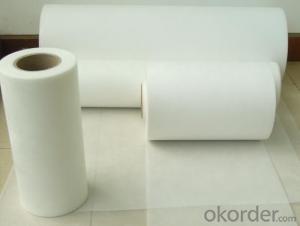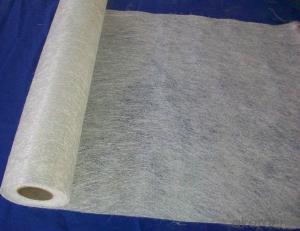Fiber Glass Surface Tissue Mat Low Binder Content
- Loading Port:
- China Main Port
- Payment Terms:
- TT or LC
- Min Order Qty:
- 2000kg kg
- Supply Capability:
- -
OKorder Service Pledge
OKorder Financial Service
You Might Also Like
Description
Surfacing Tissue mainly used in the surface layers of FRP products. It features even Fiber distribution, soft feel, level and smooth fiber surface, less glue content, quick resin soak and good pattern fitness. It can improve the product surface property on corrosion resistance, compressive strength, seepage resistance, and longer service life. It is also suitable for spraying; pattern pressing and other FRP pattern technology.
Product Features:
● Fast breakdown in styrene
● Fiber dispersed evenly
● Low binder content
● Superior acid corrosion resistance
Specifications
| item | unit | scc20w | scc30w | scc30w |
Area weight | g/m2 | 20 | 30 | 50 |
| binder content | % | 7 | 6 | 6 |
| tensile strength MD | N/5cm | ≥20 | ≥25 | ≥40 |
| soaking time | S | ≤8 | ≤10 | ≤16 |
| moisture content | % | ≤0.2 | ≤0.2 | ≤0.2 |
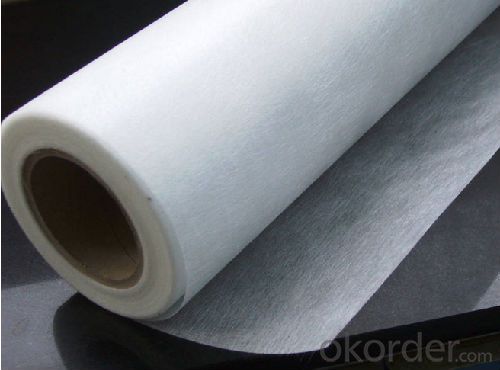
Product packaging:
Each Surface Tissue is wound onto a paper tube which has an inside diameter of 76mm and the mat roll has a diameter of 330mm. The mat roll is wrapped up with plastic film,and then packed in a cardboard box or wrapped up with kraft paper. The rolls can be vertically or horizontally placed. For transportation, the rolls can be loaded into a cantainer directly or on pallets.
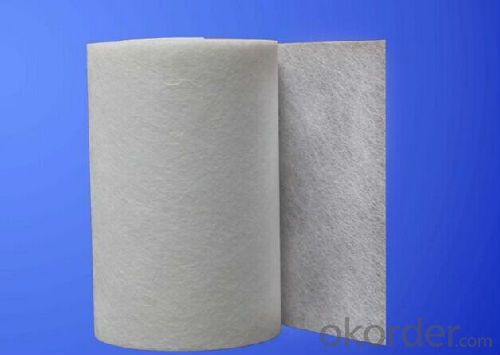
FAQ:
1.What is the delivery time ?
15days after receiving the deposit
2.Are you a trading company or factory.
We are factory,and we have more than 10 years of experience.
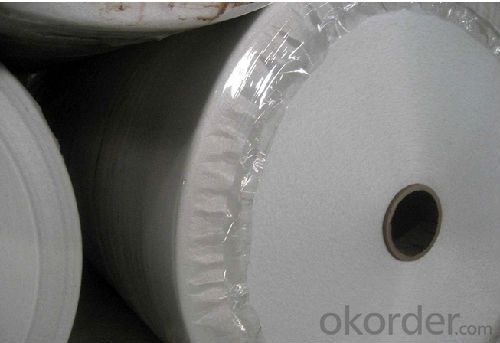
- Q:Can fiberglass fabrics be used for reinforcement in furniture or fixtures?
- Certainly! Fiberglass fabrics possess the capability of reinforcing furniture and fixtures. Renowned for their robustness, endurance, and versatility, these fabrics serve as an ideal choice for enhancing different kinds of furniture and fixtures. The frames of chairs, sofas, and other seating furniture can be fortified by employing fiberglass fabrics, providing supplementary support and stability. Furthermore, the surfaces of tables, countertops, and shelves can also be strengthened by these fabrics, elevating their capacity to endure heavy loads while resisting cracks or warps. Moreover, owing to their malleability, fiberglass fabrics can be shaped and sized as desired, enabling them to reinforce a wide range of furniture or fixtures.
- Q:How does fiberglass fabric perform in moisture absorption?
- Fiberglass fabric is known for its low moisture absorption capabilities. It has a hydrophobic nature which means it does not readily absorb water. This property allows it to maintain its strength and structural integrity even when exposed to moisture or high humidity conditions. Additionally, fiberglass fabric is resistant to mold, mildew, and rotting, further enhancing its performance in moisture absorption.
- Q:What are the different fiberglass fabric finishes for mold resistance?
- There are several different fiberglass fabric finishes available for mold resistance. Some common options include anti-fungal coatings, biocidal treatments, and antimicrobial finishes. These finishes are designed to prevent the growth of mold and mildew on the surface of the fiberglass fabric, making it ideal for use in environments where moisture and humidity are present.
- Q:How is fiberglass fabric produced?
- Fiberglass fabric is produced through a process called weaving, where glass fibers are interlaced together to form a strong and flexible fabric. These glass fibers are created by melting glass at high temperatures and then extruding it through tiny holes to form thin strands. These strands are then gathered together and woven into a fabric using specialized machines. After weaving, the fabric is often treated with a resin or coating to enhance its strength and durability.
- Q:Can fiberglass fabric be used for reinforcement in oil storage tanks?
- Fiberglass fabric, with its lightweight and robust nature, proves to be a viable option for reinforcing oil storage tanks. This material, known for its exceptional corrosion resistance and impressive tensile strength, not only enhances the structural integrity of the tanks but also helps avert any leakage or potential failure. Moreover, fiberglass fabric's non-reactive nature towards oil and other commonly stored chemicals further bolsters its suitability for this purpose. Ultimately, the utilization of fiberglass fabric in reinforcing oil storage tanks leads to heightened durability, safety, and longevity of these tanks.
- Q:Is fiberglass fabric resistant to tearing?
- Indeed, fiberglass fabric possesses remarkable resistance to tearing. Renowned for its exceptional tensile strength and durability, fiberglass fabric surpasses other fabrics in terms of tear prevention. Comprised of interwoven strands of fiberglass, this reinforced material significantly bolsters its ability to resist tearing. Moreover, fiberglass fabric is frequently subjected to specialized coatings, further heightening its tear resistance attributes. Consequently, it proves ideal for numerous applications necessitating tear resistance, including the production of protective apparel, aerospace constituents, and industrial applications.
- Q:How is fiberglass fabric used in the production of composite materials?
- Due to its exceptional strength and durability, fiberglass fabric is commonly utilized in the manufacturing of composite materials. This fabric is composed of thin strands of glass fibers that are woven together to form a lightweight and flexible material. In composite material production, fiberglass fabric functions as a reinforcing layer. It is often combined with a resin matrix, such as epoxy or polyester, to produce a composite structure with improved mechanical properties. The process begins by applying the resin matrix onto the fiberglass fabric. This is typically achieved through a technique known as wet layup or wet lay-in. The fabric is thoroughly saturated with resin, ensuring a uniform coating. Excess resin is then removed in order to achieve the desired resin-to-fiber ratio. Once the resin is applied, the fiberglass fabric is frequently layered or stacked to create a composite laminate structure. Multiple layers can be added to enhance the strength and stiffness of the final product. This layering technique enables strategic placement of the fabric for targeted reinforcement. Following the layering process, the composite structure undergoes a curing process. This involves subjecting the materials to heat or pressure, which activates the chemical reaction in the resin matrix. As the resin cures, it hardens and bonds the layers of fiberglass fabric together, resulting in a sturdy and rigid composite material. The utilization of fiberglass fabric in composite production offers numerous advantages. Firstly, fiberglass possesses excellent tensile strength and stiffness, making it well-suited for applications that require structural integrity. It also exhibits high resistance to corrosion, moisture, and chemicals, rendering it suitable for diverse environments. Additionally, the lightweight nature of fiberglass fabric helps reduce the overall weight of the composite material, making it more efficient for applications where weight is a concern. In summary, fiberglass fabric plays a pivotal role in the production of composite materials, providing strength, durability, and flexibility. Its integration into the resin matrix creates a composite structure that combines the superior properties of both materials, resulting in a wide range of applications across industries such as aerospace, automotive, construction, and marine.
- Q:Glass fiber cloth and glass fiber?
- Glass fiber is a kind of inorganic nonmetallic material with excellent properties. English name is: glass, fiber or fiberglass. Composition of silica, alumina, calcium oxide, boron oxide, sodium oxide, Magnesium Oxide etc.. It is prepared by high temperature melting, wire drawing, winding and weaving process with glass balls or waste glass as. All kinds of products formed finally, glass fiber monofilament diameter from a few microns to twenty micron, the equivalent of a hair 1/20-1/5, each bundle of fibers are hundreds or even thousands of root root filaments, usually as a reinforcing material of complex materials, electrical insulating materials and insulation materials, circuit board, etc. and widely used in various fields of the national economy
- Q:Can fiberglass fabrics be used for upholstery or furniture applications?
- Indeed, upholstery or furniture applications can utilize fiberglass fabrics. The durability, strength, and resistance to heat and chemicals are renowned attributes of fiberglass fabrics. These remarkable qualities render them appropriate for a wide range of applications, including upholstery and furniture purposes. As a reinforcement material, fiberglass fabrics can enhance the padding or cushioning in furniture, ensuring additional support and prolonged lifespan. Furthermore, as a covering material, fiberglass fabrics exhibit resistance to stains, mold, and mildew. In conclusion, fiberglass fabrics present a versatile and enduring solution for upholstery and furniture applications.
- Q:How is fiberglass fabric different from other types of fabric?
- The composition and unique properties of fiberglass fabric set it apart from other types of fabric. Unlike natural fabrics like cotton or silk, fiberglass fabric is woven from thin strands of glass. This distinctive composition gives fiberglass fabric several advantages over other fabrics. First and foremost, fiberglass fabric is renowned for its exceptional strength and durability. The glass fibers used in its production are incredibly strong and resistant to tearing, stretching, and general wear and tear. This makes fiberglass fabric ideal for applications that require durability, such as in construction or industrial settings. Additionally, fiberglass fabric exhibits high heat resistance. The glass fibers used in its production have a high melting point, allowing the fabric to withstand extreme temperatures without deteriorating or catching fire. This makes fiberglass fabric suitable for use in applications where heat resistance is crucial, such as in fire-resistant clothing or insulation materials. Furthermore, fiberglass fabric boasts excellent chemical resistance. It is not easily affected by most chemicals, including acids, alkalis, and solvents. This makes fiberglass fabric a preferred choice in industries where exposure to corrosive substances is common, such as chemical processing or automotive manufacturing. Moreover, fiberglass fabric is known for its lightweight nature. Despite its strength and durability, fiberglass fabric is relatively light, making it easier to handle and transport compared to other heavy-duty fabrics. This lightweight property is particularly advantageous in applications where weight is a concern, such as in the aerospace or automotive industries. Lastly, fiberglass fabric possesses excellent insulation properties. It is a poor conductor of heat and electricity, making it an effective insulator. This insulation capability is beneficial in various applications, including thermal insulation for buildings, electrical insulation for wiring, or even the production of protective clothing for workers in extreme environments. In conclusion, fiberglass fabric's exceptional strength, heat resistance, chemical resistance, lightweight nature, and insulation properties make it stand out from other fabrics. Its unique composition and advantageous properties make it a versatile and preferred choice in various industries and applications.
1. Manufacturer Overview |
|
|---|---|
| Location | |
| Year Established | |
| Annual Output Value | |
| Main Markets | |
| Company Certifications | |
2. Manufacturer Certificates |
|
|---|---|
| a) Certification Name | |
| Range | |
| Reference | |
| Validity Period | |
3. Manufacturer Capability |
|
|---|---|
| a)Trade Capacity | |
| Nearest Port | |
| Export Percentage | |
| No.of Employees in Trade Department | |
| Language Spoken: | |
| b)Factory Information | |
| Factory Size: | |
| No. of Production Lines | |
| Contract Manufacturing | |
| Product Price Range | |
Send your message to us
Fiber Glass Surface Tissue Mat Low Binder Content
- Loading Port:
- China Main Port
- Payment Terms:
- TT or LC
- Min Order Qty:
- 2000kg kg
- Supply Capability:
- -
OKorder Service Pledge
OKorder Financial Service
Similar products
New products
Hot products
Related keywords

